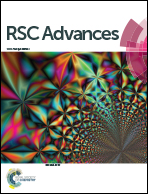New physical insights into the electromagnetic shielding efficiency in PVDF nanocomposites containing multiwall carbon nanotubes and magnetic nanoparticles
Abstract
This work attempts to bring critical insights into the electromagnetic shielding efficiency in polymeric nanocomposites with respect to the particle size of magnetic nanoparticles added along with or without a conductive inclusion. To gain insight, various Ni–Fe (NixFe1−x; x = 10, 20, 40; Ni: nickel, Fe: iron) alloys were prepared by a vacuum arc melting process and different particle sizes were then achieved by a controlled grinding process for different time scales. Poly(vinylidene fluoride), PVDF based composites involving different particle sizes of the Ni–Fe alloy were prepared with or without multiwall carbon nanotubes (MWNTs) by a wet grinding approach. The Ni–Fe particles were thoroughly characterized with respect to their microstructure and magnetization; and the electromagnetic (EM) shielding efficiency (SE) of the resulting composites was obtained from the scattering parameters using a vector network analyzer in a broad range of frequencies. The saturation magnetization of Ni–Fe nanoparticles and the bulk electrical conductivity of PVDF/Ni–Fe composites scaled with increasing particle size of Ni–Fe. Interestingly, the PVDF/Ni–Fe/MWNT composites showed a different trend where the bulk electrical conductivity and SE scaled with decreasing particle size of the Ni–Fe alloy. A total SE of −35 dB was achieved with 50 wt% of Ni60Fe40 and 3 wt% MWNTs. More interestingly, the PVDF/Ni–Fe composites shielded the EM waves mostly by reflection whereas, the PVDF/Ni–Fe/MWNT shielded mostly by absorption. A minimum reflection loss of −58 dB was achieved in the PVDF/Ni–Fe/MWNT composites in the X-band (8–12 GHz) for a particular size of Ni–Fe alloy nanoparticles. This study brings new insights into the EM shielding efficiency in PVDF/magnetic nanoparticle based composites in the presence and absence of conducting inclusion.



 Please wait while we load your content...
Please wait while we load your content...